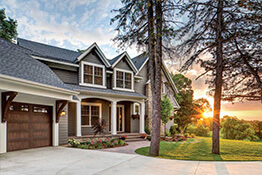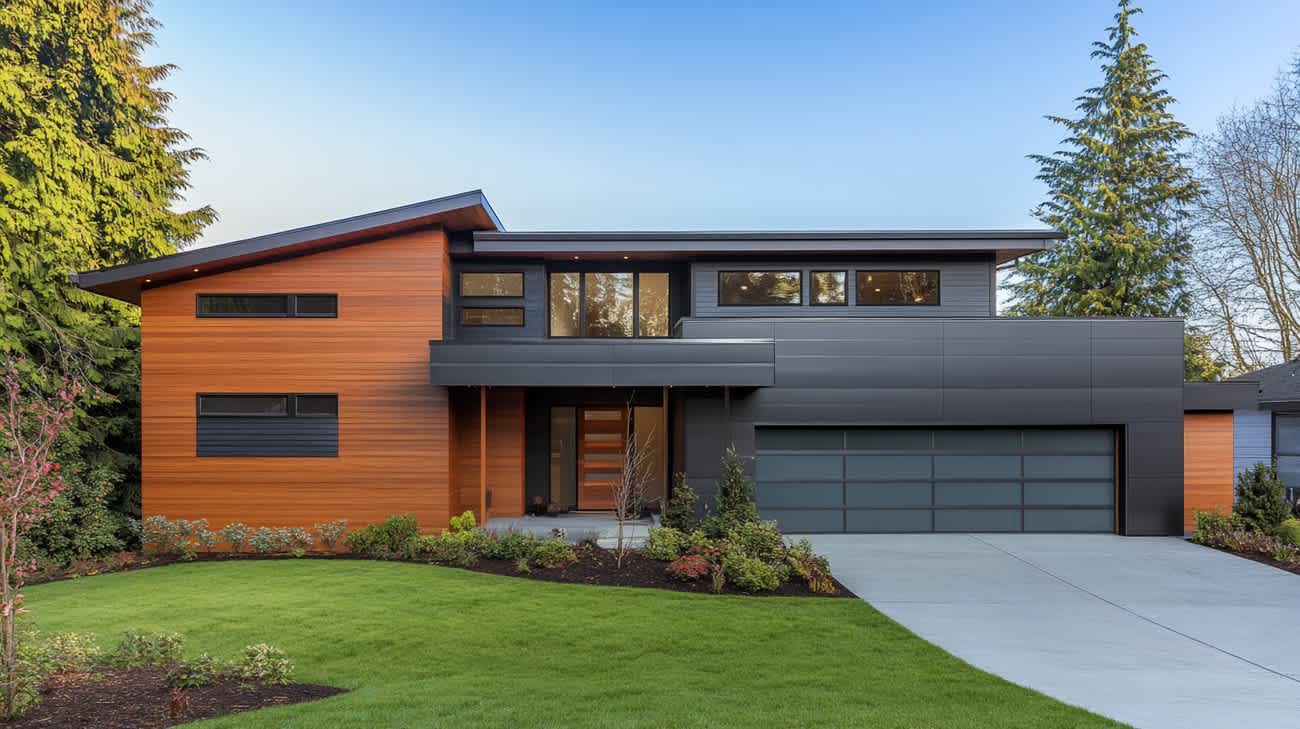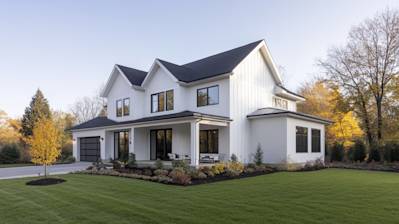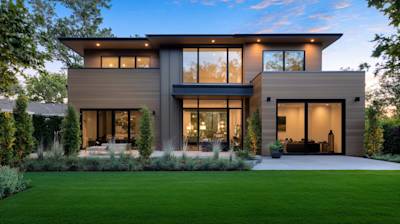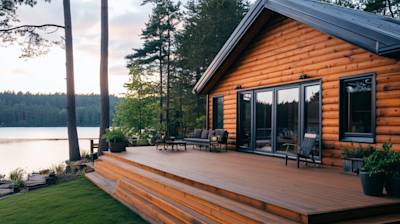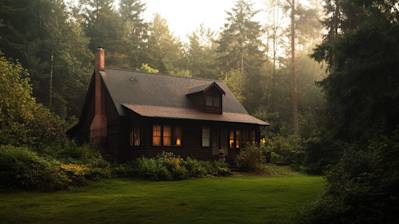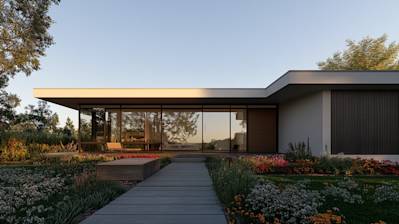When it comes to breathing life into your exterior design, vertical siding options rise as daring contenders, creating a unique aesthetic that stands out. Whether you reside in an urban landscape or a rural hideaway, the right choice of siding texture and color schemes can transform your home's exterior into an architectural masterpiece - all while delivering highly functional benefits such as weather resistance and insulation. This comprehensive guide dives into the nitty-gritty of vertical siding options to help you make an informed decision for your next home project.
Understanding Vertical Siding: A Quick Primer
Before we delve into the various vertical siding options, it's crucial to understand what vertical siding is. Unlike horizontal siding that runs along the length of a house parallel to the ground, vertical siding runs upwards, creating linearity that appeals to those with modern tastes. The key styles within this category predominantly feature two types of siding: board and batten, and panel siding.
Board and Batten Siding Reimagined
A classic choice for country-style homes, board and batten siding is a timeless classic that has been reborn. This siding style involves installing wide boards vertically and overlaying them with narrower battens to seal the joints.
Variations of Board and Batten Siding
- Standard Board and Batten: The traditional form with evenly spaced boards and battens.
- Reverse Board and Batten: The gap between boards is larger compared to the size of the boards, creating an in-and-out pattern.
- Batten on Batten: Boards are installed edge-to-edge without any gaps, and then battens are layered over.
Panel Siding: A Contemporary Stalwart
Another popular vertical siding option, panel siding, has gained traction for its sleek and modern aesthetic. It involves installing large, flat panels vertically along the exterior walls, resulting in a smooth and seamless finish.
Variations of Panel Siding
- Sheet Paneling: Large sheets of natural or engineered wood are used, offering a warm, natural look.
- Vinyl Paneling: This consists of vinyl panels that offer a cost-effective, durable, and low-maintenance siding option.
- Metal and Aluminum Panels: Metal or aluminum panels provide a futuristic and sleek look that's often associated with industrial and contemporary structures.
Material Considerations: What's Your Preference?
Your choice of siding isn't solely dependent on the style; the material also plays a significant role. Let's take a closer look at some popular materials for vertical siding.
Wood Siding
Wood offers a beautiful, natural look and is a popular choice for those after a rustic, classic aesthetic. However, it does require regular maintenance to prevent weather damage and decay.
Vinyl Siding
Vinyl siding is low maintenance, cost-effective, and can be molded to imitate natural materials like wood. It's available in an assortment of colors, allowing homeowners to customize their exterior to their liking.
Metal Siding
Metal siding provides a contemporary, industrial vibe. Aluminum and steel are two popular choices, both offering longevity and strength, but they can be more expensive than other options.
Composite Siding
Designed to withstand the harshest of weather conditions, composite or engineered siding resists rotting, warping, and cracking — all while mimicking the visual warmth of natural wood.
Best Practices for Vertical Siding Installation
Though it may seem tempting to take on this project yourself, remember that installing siding is a complex process that calls for professional experience. However, if you decide to go the DIY route, consider these tips:
- Always start installing from the corner and across the width of the house.
- Make sure the siding is securely fastened to avoid loosening due to weather conditions.
- Periodically check for correct alignment to ensure an even finish.
- Follow the manufacturer’s installation guidelines to ensure the product warranty stands valid.
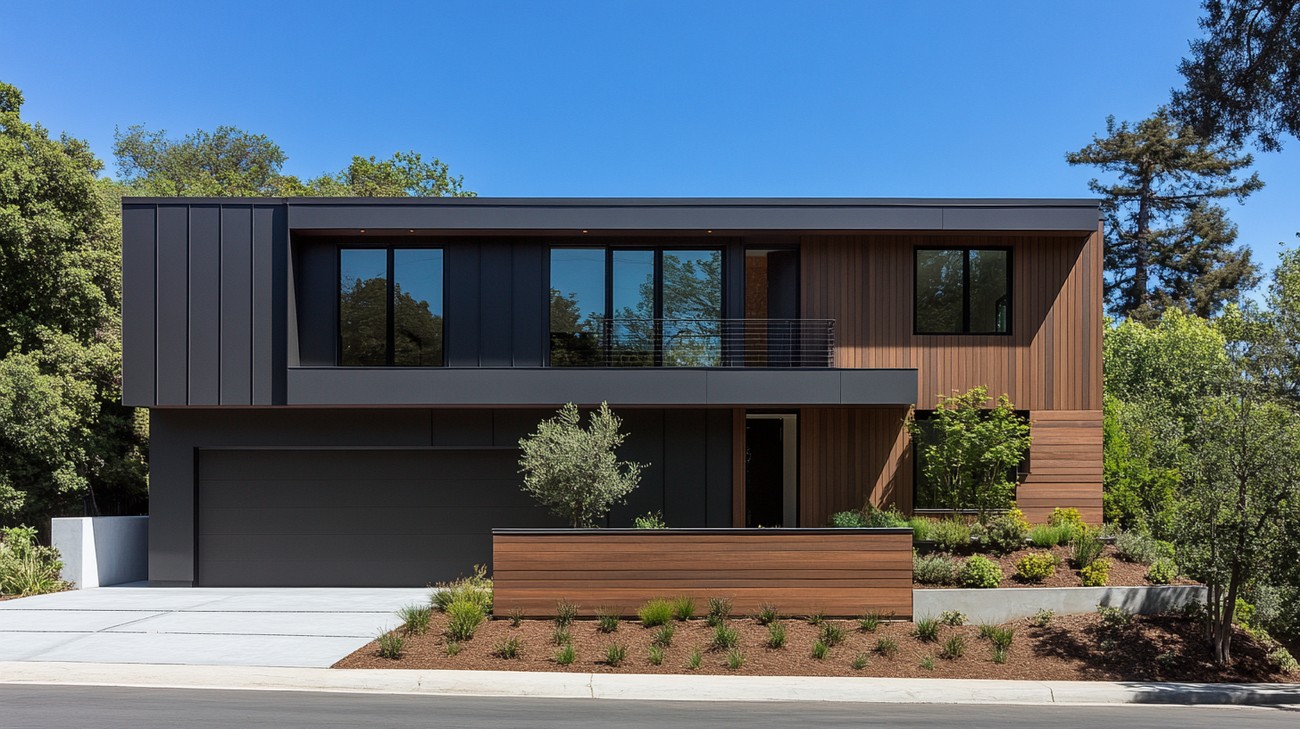
Frequently Asked Questions about Vertical Siding Options
Is vertical siding maintenance-intensive?
Maintenance of vertical siding varies depending on the material used. For example, vinyl siding is largely low maintenance, requiring only periodic cleaning with mild soap and water. However, wood siding can require more care, including regular painting and sealing to prevent rot and insect damage.
How long does vertical siding typically last?
The lifespan of your siding depends on the material used and how well it's maintained. Most vertical siding materials like vinyl and fiber cement can last several decades with proper care. Wood siding can also last a long time, but it needs more regular maintenance to prevent issues like rot and insects.
Can vertical siding be installed over existing siding?
Yes, it’s possible to install vertical siding over existing siding. However, this depends on the condition and type of the current siding. For example, if the existing siding is uneven or damaged, it will need to be repaired or removed before installing the new siding. Always consult with a siding professional to make sure this method is right for your specific circumstance.
What are the color options for vertical siding?
The color options for vertical siding are nearly endless. From neutrals like beige and gray to bold reds and blues, there are options to suit every style and taste. Keep in mind, each siding material will have specific color options available. For instance, vinyl siding is available in virtually any color, while natural wood siding can be stained or painted in a range of shades.
Does vertical siding offer good insulation?
The insulative properties of vertical siding can depend on the material used. Vinyl and fiber cement siding don't offer much natural insulation, but they can be installed with additional insulating materials. Steel, aluminum, and wood siding have moderately good natural insulating properties.
Can vertical siding improve the value of my home?
Choosing high-quality, durable and attractive vertical siding can contribute to curb appeal, potentially increasing the value of your home. It can also provide additional insulation, which can lower energy costs and increase home value.
Can vertical siding be used in any climate?
Yes, vertical siding can be used in a variety of climates. However, the specific material used may perform better in some climates over others. For example, vinyl siding can become brittle in extremely cold temperatures and can warp in high heat. Conversely, fiber cement siding can withstand a variety of temperature and weather conditions, making it a good option for many different climates.
Are there eco-friendly vertical siding options?
Yes, many siding options can be considered environmentally friendly. For instance, fiber cement siding is made from sustainable and recyclable materials like cement, sand, and wood fibers. Also, steel siding is often made from recycled materials and can be recycled at the end of its life.

Pros of Vertical Siding Options
Aesthetics and Design Appeal
Stand Out
Vertical siding can make any property stand out, providing a modern, chic look. It gives a sharp, unique aesthetic that horizontally sided houses can’t compete with.
Height Perception
Vertical siding can provide the illusion of a taller, more stately structure. For homes or buildings that are lacking in height or size, vertical siding can help to add a few visual inches.
Choices and Variety
Vertical siding isn't just confined to wood or vinyl. There's a broad array of materials you can select from, including metal, fiber cement, and even certain types of natural stone. There are also varying styles, including board and batten, panel, and reverse board and batten.
Durability and Maintenance
Weather Resistance
Vertical siding tends to be more resistant to rain and snow damage thanks to its orientation. Water easily slides down without getting caught or accumulated, avoiding prolonged exposure that could lead to rot or deterioration.
Easier to Clean
Cleaning vertical siding is a simpler task in comparison to other types. With a good pressure washer and a little bit of elbow grease, dirt and other contaminants can be effortlessly removed.
Environmentally Friendly
Sustainable Timber
Many types of vertical siding, particularly those using timber, are made from sustainable sources. This means the materials are replaced or able to grow back again, reducing environmental impact.
Energy Efficiency
Certain vertical siding options can provide better insulation for the house, mainly if they're properly installed with the right insulation behind them. This can result in high energy efficiency, helping to reduce heating and cooling costs.
Cons of Vertical Siding Options
Installation Complexity and Costs
More Challenging to Install
Expect a more complicated installation process with vertical siding. It needs additional elements, such as furring strips for leveling the surface since it doesn't lay flat like horizontal siding.
Higher Costs
The complicated installation process elevates labor costs. If you're thinking about hiring professionals (which is usually a good idea considering the difficulty), prepare to pay more than you would for horizontal siding.
Material Sturdiness
Wood Siding Issues
Wood, while aesthetically appealing, can show signs of wear and tear over time, especially if not properly maintained. It is susceptible to pests, such as termites, and can warp or rot due to exposure to water and moisture.
Maintenance
Require Frequent Painting
Depending on the type of material, vertical siding often needs to be painted more frequently than horizontal siding. This is because it doesn't hold paint as well, leading to quicker fading or peeling off.
Damage Proneness
Though the vertical orientation is beneficial against weather conditions, it makes the siding prone to accrue damage from other sources. For instance, baseballs, hailstones, and even lawnmower debris hit with more force because of the upright position.
Limited Appeal
Not For Everyone
Even though many find vertical siding aesthetically pleasing, certain individuals or communities might find it too different or unsightly. This could potentially impact resale values or homebuyer interest.

Myths & Misconceptions About Vertical Siding Options
Myth 1: Vertical Siding Is Only for Commercial Buildings
Fact
Many homeowners have the misconception that vertical siding is only suitable for commercial buildings or larger structures like barns. However, this is not the case. Vertical siding can add a unique architectural touch to residential homes too. The vertical lines can potentially make your home appear taller, adding an unprecedented level of dimension and visual interest.
Myth 2: Installation of Vertical Siding Is More Difficult
Fact
There's a common belief that vertical siding is more complex and time-consuming to install than horizontal siding. While it’s true that installation techniques differ, it doesn't necessarily equate to one being more difficult than the other. The installation process mainly depends on the contractor's skill level and experience. With a competent contractor, installing vertical siding should be as straightforward as horizontal siding.
Myth 3: Vertical Siding Doesn't Last as Long
Fact
The longevity of your siding depends more on the material used than the orientation of the siding panels. Vinyl, metal, wood, and fiber cement all have different durability levels and maintenance requirements. Proper installation and regular maintenance play significant roles in the longevity of vertical siding. If done correctly, vertical siding can outlast many other forms of siding.
Myth 4: Vertical Siding Is More Expensive
Fact
While the price can vary depending on the type of siding material and the complexity of the installation, vertical siding isn't necessarily more costly than horizontal siding. The cost could also be offset by the potential increased home value due to the unique aesthetic appeal of vertical siding.
Myth 5: Vertical Siding Can’t Withstand Harsh Weather Conditions
Fact
Some people think that vertical siding is less effective at handling stormy weather and harsh conditions. In reality, siding orientation doesn't significantly affect its ability to withstand harsh weather. The type and quality of material, installation methods, and ongoing maintenance are more important factors.
Myth 6: Vertical Siding Requires More Maintenance
Fact
Vertical siding doesn't inherently require more maintenance than horizontal siding. The maintenance largely depends on the siding material. Vinyl siding requires minimal maintenance regardless of its orientation, whereas wood siding would need regular care to prevent warping, rotting, and pest infestations.
Myth 7: Vertical Siding Is Not Energy-Efficient
Fact
Siding on your home plays an integral part in your home's insulation and energy efficiency, but the orientation of the siding (vertical vs. horizontal) has minimal effect. Instead, energy efficiency largely depends on the type of material, the method of installation, and the efficiency of your home's overall insulation.
Myth 8: Limited Design Options with Vertical Siding
Fact
Some people may believe that vertical siding lacks variety in terms of design and colors, but this is far from the truth. Today’s vertical siding comes in a multitude of colors, textures, and styles, allowing homeowners to find the perfect fit for their aesthetic preferences and architectural style.
Myth 9: Vertical Siding Harbors More Moisture
Fact
There’s a belief that vertical siding retains more moisture than horizontal siding due to the direction of the panels, potentially leading to decay. However, proper installation and ventilation can easily prevent moisture buildup, regardless of the siding's orientation.
Myth 10: Vertical Siding is on Its Way Out
Fact
Just because vertical siding isn’t as common as horizontal siding doesn’t mean it’s an ‘outdated’ choice. In fact, many homeowners are starting to explore vertical siding as an alternative to add distinctive character to their homes. With all the benefits it offers, the popularity of vertical siding is on the rise, making it far from a fading trend.
These are just a few misconceptions about vertical siding that could confuse homeowners. It's essential to do thorough research and consult with experts to understand each siding's pros and cons before making your choice.
Summary
So, it's pretty clear that there's a lot to think about when it comes to vertical siding options. Whether you go for vinyl, metal or wood, it is essential to choose the option that best suits your home's architectural style, your budget, and your maintenance preferences. The great news is there are many choices available, each with its own unique set of benefits.
It's also worth considering some criticisms of vertical siding - there's the potential for water seepage and it can be more difficult to install, especially for DIY enthusiasts. But again, the choice of vertical siding options offers enough variety to help counteract these potential issues. For example, the ease of installation and low maintenance of vinyl sidings could be an attractive option against the possibly labor-intensive, high maintenance wood siding.
Just remember, investing in any vertical siding options requires a significant amount of thought, research, and consultation with professionals. Vertical siding can dramatically enhance the appearance of your home and potentially increase its value, making it a decision worth spending time on. With the wide array of options, you're sure to find something that complements your personal style and ticks off all the essential boxes.
About US Quality Construction of Columbus
US Quality Construction of Columbus, based in the heart of Ohio, is your go-to solution for top-tier construction services. We're a locally-owned company, so we know the neighborhoods of Columbus like the back of our hands. We take pride in using our extensive knowledge coupled with unwavering dedication to bring your projects to life. Our skilled construction professionals are known for their keen attention to detail, and we're super passionate about delivering a final product that would leave you smiling every time! So, whether it's a home renovation or a commercial build-out, US Quality Construction of Columbus is always ready to roll up our sleeves and get down to work!
Tags: siding, vertical, options,
